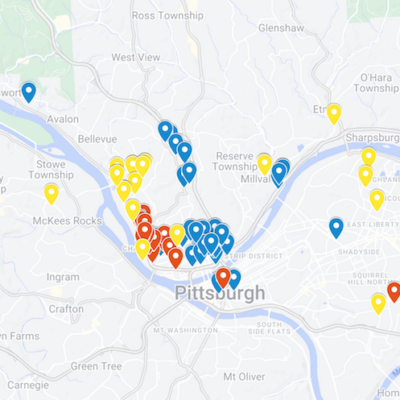
The first Jewish settlers on the North Side of Pittsburgh arrived in the 1850s, when the area was an independent municipality called Allegheny City. They were largely drovers who worked in the local livestock yards or merchants commuted into downtown Pittsburgh. A group formed the Young Mens Sephar Club in 1860 and held what was likely the first Siyum Sefer Torah celebration in the region. They were associated with Rodef Shalom Congregation, which was briefly located in Allegheny City before 1862.
In the years following the Civil War, the western end of Allegheny City became home to approximately one-quarter of the total Jewish population of the twin cities. These were largely Jewish families of German origin, as well as some of the more established families of Lithuanian, Dutch, and Posener origin. They lived largely in a five-block stretch of Sheffield and Fayette Streets, as well as some surrounding streets in the area. They totaled some 1,000 people by 1889. In the early years of the 20th century, these Jewish families began leaving Allegheny City for the emerging eastern neighborhoods, specifically the northern half of Squirrel Hill and neighboring Shadyside.[1]Feldman, Jacob. “The Jewish Experience in Western Pennsylvania,” Pittsburgh: Historical Society of Western Pennsylvania, 1986 (catalog record).
As those initial Jewish families were leaving Allegheny City, more recent Jewish immigrants were beginning to arrive in the area. A group living and working in the Deutschtown area of eastern Allegheny City chartered Beth Israel Congregation in 1907. A second group located in the Manchester neighborhood of western Allegheny City chartered Beth Jehuda Congregation in 1913. A third group of families living farther north in Woods Run briefly organized the Woods Run Congregation and school in the 1920s.
The North Side was also home to several Jewish communal institutions independent of these congregations. The J. M. Gusky Orphanage operated from a campus on Perrysville Avenue from 1891 until 1943. Western State Penitentiary in Woods Run had a Jewish congregation called Agudus Achim for a short period of time in the early 1920s.
The city of Pittsburgh annexed Allegheny City in 1906, creating a large section known as the North Side. The Jewish population of the North Side began declining with the growth of new middle class communities in the eastern part of the city. The Jewish population of the entire North Side was around 1,300 by the late 1930s but had become negligible by the early 1960s.[2]Kuntz, Leonard Irvin, “The Changing Pattern of the Distribution of the Jewish Population of Pittsburgh From Earliest Settlement to 1963.” (1970). LSU Historical Dissertations and Theses. … Continue reading
References
| ↑1 | Feldman, Jacob. “The Jewish Experience in Western Pennsylvania,” Pittsburgh: Historical Society of Western Pennsylvania, 1986 (catalog record). |
|---|---|
| ↑2 | Kuntz, Leonard Irvin, “The Changing Pattern of the Distribution of the Jewish Population of Pittsburgh From Earliest Settlement to 1963.” (1970). LSU Historical Dissertations and Theses. 1864. (online—LSU Historical Dissertations and Theses). |